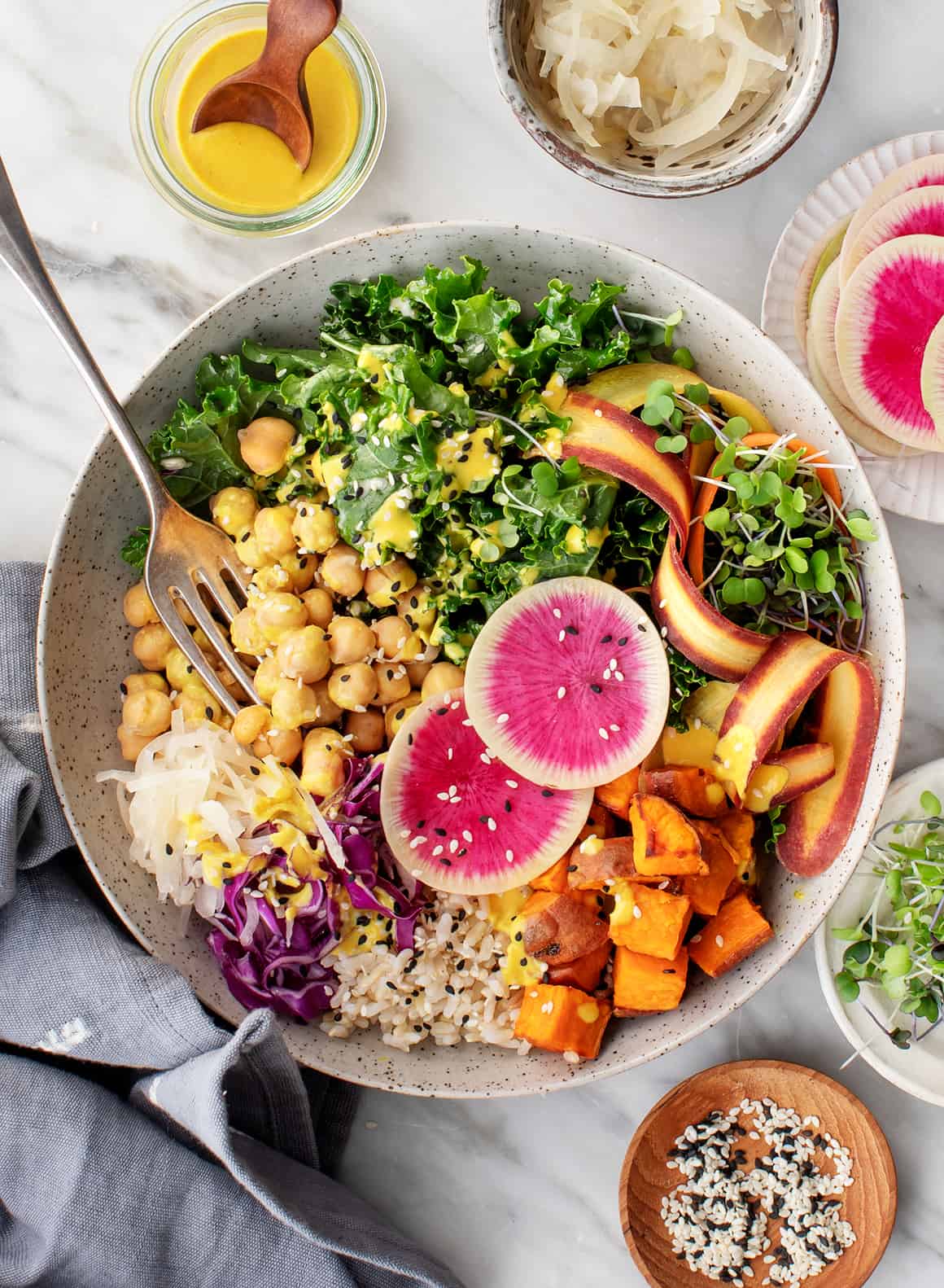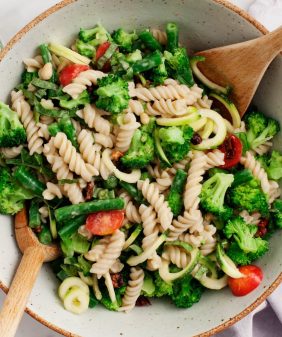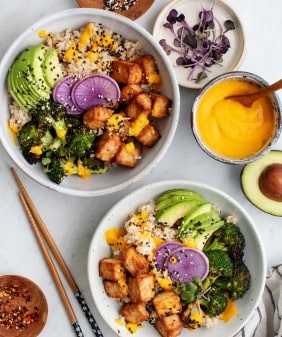The ultimate nutrient-packed vegan buddha bowl! Fresh veggies, beans, sauerkraut, and a vibrant turmeric tahini sauce make it hearty and flavorful.

Where did the name ‘Buddha Bowl’ come from, anyway? If you’ve been on Instagram in the last 5 years, chances are you’ve seen these colorful bowls, packed with plant-based goodness like grains, legumes, steamed and raw veggies, and flavorful sauces. According to a 2017 Epicurious article by Katherine Sacks, the name could come from how Buddha collected alms, using a large bowl to gather small bits of food that the residents of whatever village he was staying in could afford to share.
Before we started calling these colorful bowls “Buddha Bowls,” I knew them as macro bowls. When we lived in Austin, I headed to a macrobiotic restaurant called Casa de Luz whenever I needed a bit of a recharge. Instead of having a fixed menu, Casa de Luz offered one rotating meal per day. It would always be some type of buddha bowl, with a grain, a legume, blanched leafy greens, steamed vegetables, a pickled vegetable, and a delicious sauce. It may sound limiting, but I’ve honestly had some of the best sauce and vegetable pairings of my life there. Since I can’t visit Casa de Luz regularly now that we live in Chicago, I used their basic template to build my own buddha bowl recipe.

My Buddha Bowl Recipe Ingredients
To make a homemade version of a Caza de Luz macro bowl, I used one item from each of these categories:
- A delicious sauce – I made a vibrant turmeric tahini sauce. It’s my favorite type of creamy sauce in that it doesn’t require a blender, so you can stir it together in no time. And if you have leftovers, you’re in luck! This colorful sauce tastes great on everything.
- Cooked vegetables – Roasted sweet potatoes were my pick.
- Raw vegetables – Watermelon radish, rainbow carrots, and red cabbage give this buddha bowl recipe a huge pop of color!
- Leafy greens – Bring on the kale.
- A legume – I chose my go-to plant-based protein: chickpeas!
- A grain – I used brown rice, but if you don’t have any on hand, feel free to substitute white rice.
- A pickled vegetable – Sauerkraut! I love Bubbies.
These components all keep nicely in the fridge if you want to meal prep this recipe for lunch during the week. Find my best meal prep tips here and more of my favorite healthy lunch recipes here!

Vegan Buddha Bowl Recipe Variations
I love this recipe as written, but feel free to customize your buddha bowl. Here are a few of my favorite variations:
- Vary the veggies. Replace the sweet potato with roasted butternut squash or regular potatoes, or try a different kind of roasted veggie. Roasted Brussels sprouts, roasted broccoli, cauliflower, asparagus, or beets would all be great. You could also try cooking them in different ways. Steam or sauté the kale instead of leaving it raw, steam or roast the carrots, or boil the sweet potatoes. In the summer, grilled veggies would be great here too!
- Swap in a different protein. Try edamame, lentils, black beans (or any kind of beans), or top your grain bowls with cubes of crispy tofu or tempeh. For extra crunch, you could even use roasted chickpeas!
- Change up the grain. Replace the rice with quinoa, farro, or couscous. For extra veggie power, skip the grain, and swap in cauliflower rice or broccoli rice.
- Switch the sauce. Make a different variation of my basic tahini sauce recipe, or use a different sauce entirely! I love finishing a buddha bowl with peanut sauce, lemon vinaigrette, green goddess dressing, cilantro lime dressing, hummus, or drizzles of sesame oil and soy sauce or tamari.
- Try a different pickle. Don’t have sauerkraut on hand? Use pickled red onion or jalapeños instead!
Let me know what variations you try!

More Favorite Plant-Based Recipes
If you love this buddha bowl recipe, find 85 more delicious vegan recipes here, or try one of these healthy bowls next:
- Rainbow Kale Salad
- Sesame Soba Noodles
- Roasted Veggie Grain Bowl
- Sweet Potato Quinoa Bowl
- Or any of these 15 Best Rice Bowl Recipes!

Best Buddha Bowl
Ingredients
- 1 large sweet potato, cubed
- Extra-virgin olive oil, for drizzling
- 1 watermelon radish or 2 red radishes
- 2 medium carrots
- 1 cup shredded red cabbage
- Lemon wedge, for squeezing
- 8 kale leaves, chopped
- 2 cups cooked brown rice or quinoa
- 1 cup cooked chickpeas or cooked lentils
- ¾ cup sauerkraut or other fermented veggie
- 2 tablespoons sesame seeds or hemp seeds
- Turmeric Tahini Sauce, for serving
- Microgreens, optional
- Sea salt and freshly ground black pepper
Instructions
- Preheat the oven to 400°F and line a large baking sheet with parchment paper.
- Toss the sweet potatoes with olive oil, salt, and pepper, and spread onto the baking sheet. Roast for 20 minutes, or until golden brown.
- Thinly slice the radish into rounds (this is best done on a mandoline), and use a vegetable peeler to peel the carrots into ribbons.
- Toss the radish slices, carrots, and shredded cabbage with a squeeze of lemon. Set aside.
- Place the kale leaves into a large bowl and toss with a squeeze of lemon and a few pinches of salt. Use your hands to massage the leaves until they become soft and wilted and reduce in the bowl by about half.
- Assemble individual bowls with the brown rice, chickpeas, kale, carrots, radishes, cabbage, sweet potatoes, sauerkraut, sesame seeds, and microgreens, if using. Season with salt and pepper and serve with the Turmeric Tahini Sauce.














Excellent!
Excellent and easy!
Thank you so much for all of your delicious recipes. Including this one. So very well organised and all recipes easy to follow.🥰
Hi Angela, thanks for your sweet comment! So glad you enjoyed the recipe.
i can’t find your turmeric tahini sauce
Loved everything about this. So satisfying and delicious!
Delish! Never knew how to soften Kale before this. We meal prepped these for lunches this week, cannot wait. Excellent texture! We added some chicken, but totally not necessary
Hi Jenn, I’m so glad you loved it!
what is the seving size please
This was so good!! Especially loved the turmeric tahini dressing.
Hi Sarah, I’m so glad you loved it!
How do I find the nutritional values for these meals? I made a Buddha bowl but I really need the fiber, carb and protein amounts per serving and what is a serving size? Oh and calories.
Hi Debbi, unfortunately, we don’t calculate nutrition facts for our recipes, but you could use an online nutrition calculator like MyFitnessPal to get an estimate.